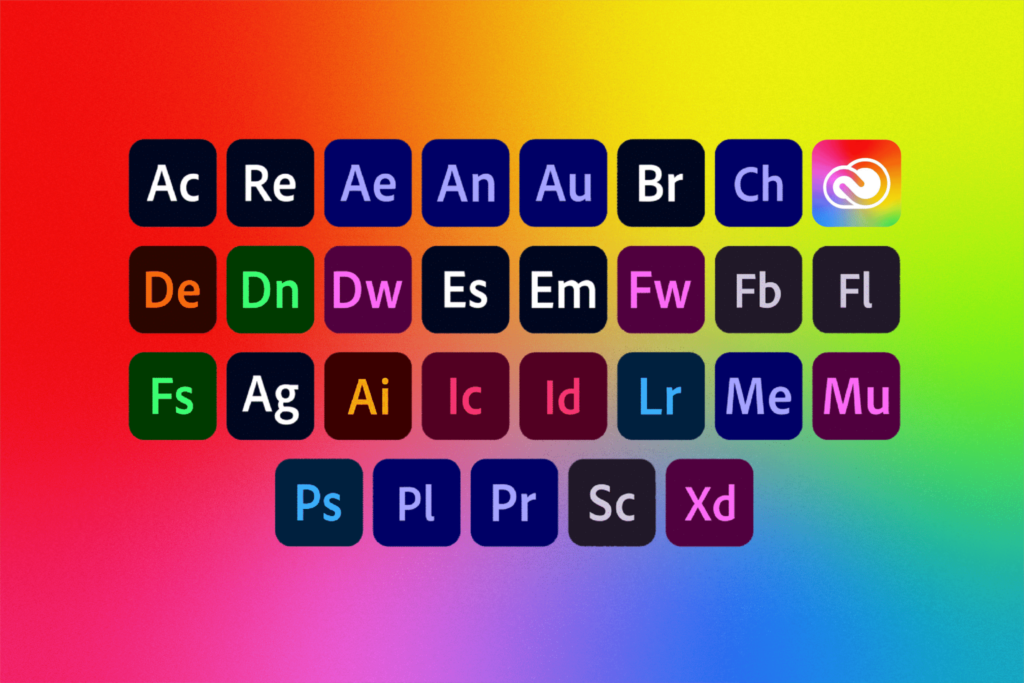Adobe, officially known as Adobe Systems, is an American software company renowned for its multimedia and creativity software products. Founded in 1982 by John Warnock and Charles Geschke, Adobe is headquartered in San Jose, California. The company derived its name from Adobe Creek, a watercourse that ran behind the founders’ residences.
Initially, Adobe focused on digital fonts as one of its first products before entering the consumer software market in the 1980s. Their debut consumer software was Adobe Illustrator, a vector-based drawing program for Mac computers. In 1989, Adobe released Photoshop, which quickly became their flagship product. They further expanded their product line with Adobe Acrobat and Reader, which popularized the PDF format, now an international standard.

Adobe Creative Cloud Image: Shutterstock
One of Adobe’s notable offerings is the Adobe Creative Cloud, a Software-as-a-Service (SaaS) package that provides access to a wide range of creative tools based on subscription levels. While Photoshop remains the most prominent product in the Creative Cloud lineup, it also includes other industry-leading applications such as Premiere Pro, After Effects, Illustrator, Acrobat, Lightroom, and InDesign. Additionally, users gain access to resources like fonts, stock images, and other creative assets.
Data Breach Incident In 2013, Adobe experienced a significant data breach that had a profound impact on the company and its users. Initially reported to affect 2.9 million users, it was later revealed that approximately 38 million active users had been exposed. The attackers gained access to user IDs, encrypted passwords, and also managed to acquire a portion of the source code for Photoshop.
Despite the data breach incident, Adobe has continued to innovate and provide essential software tools for creative professionals and individuals worldwide. Their products have become industry standards and remain widely used across various fields, making Adobe a prominent player in the software industry.
History
Adobe, formerly known as Adobe Systems, was founded in 1982 by John Warnock and Charles Geschke. The company’s name was inspired by Adobe Creek, a stream located behind Warnock’s house in Los Altos, California. The creek derived its name from the clay found there, as “Adobe” is a Spanish word for mudbrick, symbolizing the creative nature of Adobe’s software. The original corporate logo, featuring a stylized “A,” was designed by Marva Warnock, John Warnock’s wife. In 2020, Adobe updated its visual identity, including a new all-red logo.
In its early days, Adobe caught the attention of Steve Jobs, who attempted to acquire the company for $5 million in 1982. Although Warnock and Geschke initially refused the offer, they eventually sold shares worth 19 percent of the company to Jobs. This landmark deal, which included a five-year license fee for PostScript, made Adobe the first profitable company in Silicon Valley’s history.
Adobe’s focus shifted to specialized printing software, leading to the development of the Adobe PostScript page description language. PostScript became the first internationally recognized standard for computer printing, supporting various languages and connecting with typesetting manufacturers. Adobe continued to innovate, introducing digital fonts in a proprietary format called Type 1.
In the mid-1980s, Adobe entered the consumer software market with Illustrator, a vector-based drawing program that helped popularize PostScript-enabled laser printers. In 1989, Adobe launched Photoshop, which quickly became its flagship product and dominated the graphics editing market. In 1993, Adobe introduced the Portable Document Format (PDF) along with its Adobe Acrobat and Reader software. PDF has since become an international standard.
Throughout the years, Adobe expanded its product line through strategic acquisitions. In 2005, Adobe acquired Macromedia, its main rival, adding products like Dreamweaver, Flash, and Director to its portfolio. Adobe further expanded its offerings with the acquisitions of companies like Omniture, Nitobi Software (creator of PhoneGap), and Marketo.
In recent years, Adobe has focused on AI and machine learning technologies, collaborating with NVIDIA to enhance its Sensei AI framework. The company also made significant acquisitions, such as Magento Commerce for e-commerce services and Frame.io for cloud-based video collaboration. In 2021, Adobe announced plans to add payment services to its e-commerce platform.
Adobe’s impact extends beyond its software. The company has faced challenges, including a major security breach in 2013 and legal issues related to employee compensation. However, it has continued to innovate and adapt to changing industry demands.
In 2022, Adobe made headlines by announcing its agreement to acquire Figma, a software design start-up, in a deal valued at $20 billion. This acquisition is currently under review by regulatory authorities.
Adobe Software List: A Comprehensive Guide for Creatives
Below is an extensive Adobe software list that provides an overview of each program’s purpose and functionality.
- Photoshop: A powerful photo editing software (Free 7 Day Trial).
- Illustrator: The industry-standard vector graphics software (Free 7 Day Trial).
- Acrobat Pro: A collaborative tool for creating and editing PDF files.
- InDesign: Software for layout and page design.
- Premiere Pro: The leading video editing software.
- After Effects: Software for motion graphics and visual effects animation.
- Lightroom: Cloud-based photo editing software.
- Premiere Rush: A simplified video editing app.
- Adobe XD: An all-in-one UI/UX design tool.
- Adobe Express (Formerly Adobe Spark): An app for creating social media graphics and videos.
- Adobe Animate: Software for 2D animation.
- Adobe Dreamweaver: Responsive website design software.
- Adobe Stock: A platform for accessing royalty-free photos, illustrations, and videos.
- Adobe Substance (3D Stager, Painter, Sampler, Designer): The ultimate 3D design tool for building real-time scenes.
- Adobe Audition: An all-in-one audio workstation.
- Adobe Fonts: Unlimited font options for personal and commercial use.
- Adobe Aero: Augmented reality software.
- Adobe InCopy: A collaborative word processor for copywriters and editors.
- Adobe Document Cloud: The world’s leading PDF and electronic signature solutions.
- Adobe Experience Cloud: Personalized customer experience solutions, covering content to campaign management.
- Adobe Fresco: A digital art app for iPhone and iPad.
- Adobe Dimension: Software for creating photorealistic scenes.
- Adobe FireFly: An AI Art Generator and AI photo editing tool (Now in Beta).
This comprehensive range of Adobe software provides creatives with a diverse set of tools to enhance their productivity and bring their artistic vision to life.
What is Adobe Used for?
Adobe offers a wide range of software programs, each serving diverse purposes based on the specific product you’re using.
With Adobe, you can engage in various activities such as designing graphics, editing photos, creating animations, building websites, producing videos, editing audio, and much more. As long as you have a computer and the appropriate program, Adobe has the tools to meet your needs.
What Adobe Products are Available?
Let’s quickly explore the different types of Adobe software and who commonly uses them:
- Graphic Design Software:
- Adobe PhotoshopAdobe PageMakerAdobe LightroomAdobe InDesignAdobe InCopyAdobe ImageReadyAdobe IllustratorAdobe FreehandAdobe FrameMakerAdobe FireworksAdobe AcrobatAdobe XD
- Web Design Software:
- Adobe Muse
- Adobe GoLive
- Adobe Flash Builder
- Adobe Flash
- Adobe Edge
- Adobe Dreamweaver
- Adobe Contribute
- Video Editing, Animation, and Visual Effects Software:
- Adobe Ultra
- Adobe Spark Video
- Adobe Premiere Pro
- Adobe Premiere Elements
- Adobe Prelude
- Adobe Encore
- Adobe Director
- Adobe Animate
- Adobe After Effects
- Adobe Character Animator
Adobe also offers audio editing software, eLearning software, and digital marketing and management software, such as Adobe Marketing Cloud.
What are the Most Popular Adobe Certifications?
Several popular Adobe qualifications allow you to become certified in specific Adobe programs. Here are some examples:
- Adobe Dreamweaver Courses:
- Learn how to build, publish, and manage websites and applications using Adobe Dreamweaver.
- Adobe Flash Courses:
- Learn to create rich content, including vector graphics, animations, mobile applications, and games using Adobe Flash.
- Adobe Illustrator Courses:
- Learn to use Illustrator for creating artwork in both print and online projects.
- Adobe InDesign Courses:
- Gain proficiency in the industry-standard publishing application for print and online projects, ranging from posters and brochures to magazines, newspapers, and books.
- Adobe Photoshop Courses:
- Master one of Adobe’s most popular programs for editing, manipulating, and retouching images, as well as creating image compositions and website mockups.
- Adobe Premiere Courses:
- Develop skills in producing professional-quality videos using Adobe Premiere, a timeline-based video editing platform. Learn to add effects, perform grading, create titles, and utilize other features.
These certifications provide valuable expertise and enhance your proficiency in specific Adobe software, enabling you to excel in various creative fields.


